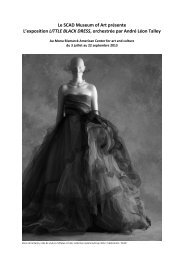Press Release - Mona Bismarck | American Center
Press Release - Mona Bismarck | American Center
Press Release - Mona Bismarck | American Center
Create successful ePaper yourself
Turn your PDF publications into a flip-book with our unique Google optimized e-Paper software.
THE CHALLENGE OF PRINTMAKING<br />
Organized thematically, this exhibition is displayed in the three galleries of the MBAC. The first<br />
gallery introduces the artist, her favorite models and the different printmaking techniques she<br />
employed. The second gallery illustrates the Japanese influence on Cassatt’s work, and the third<br />
shows her pastel counterproofs. The Vollard collection includes multiple different states of prints,<br />
which gives visitors a unique opportunity to follow the step-by-step development and evolution of<br />
her works.<br />
1 - The Printmaker’s "Kitchen"<br />
In the 1870s, printmaking was considered a "minor" art, especially because of its reproducible<br />
nature. Mary Cassatt, however, saw in it a tool of research with untapped potential. Thus, she<br />
devoted herself diligently to the many possibilities of the medium, which played a major role in her<br />
work. Her career as a printmaker really began in 1879 when she accepted an invitation from Degas to<br />
join the Impressionist group in their fourth exhibition. Before then, she had only tried etching and<br />
had not yet approached color sequences.<br />
Cassatt’s first prints were made in 1879-80; they are accompanied in the exhibition by preparatory<br />
drawings and show a strong desire for experimentation. The main themes of these works are:<br />
theatre (for instance In the Opera Box or Two Young Ladies in a Loge, Facing Right), domestic life<br />
(Mrs. Cassatt Reading to her Grandchildren, Before the Fireplace, or Lydia at Afternoon Tea), family<br />
scenes and upper-class daily activities. Unlike traditional printmaking, Mary Cassatt did not try to<br />
define figures but rather to suggest their moods through the manipulation of shadow and light.<br />
Indeed, the artist would often trace from a sheet of paper onto the copper plate so that the<br />
freshness of her inspiration would show through.<br />
In 1889, after several years of creating only a few prints, she started working in drypoint and<br />
produced an important body of work, including Quietude and The Caress. Many of these drypoints<br />
consist of a mostly bare surface covered by an inked veil that creates an atmosphere. Others, such as<br />
The Mandolin Player and Tea, are more finished and demonstrate a more complete means of<br />
pictorial expression.<br />
2 - The Japanese Influence<br />
Mary Cassatt refined her techniques in soft ground etching and aquatint in order to combine and mix<br />
them in more ambitious color prints: a new direction she took after visiting the 1890 exhibition of<br />
Japanese woodblock prints at the Ecole des Beaux-Arts in Paris (with Berthe Morisot). The “set of<br />
ten” color prints that resulted were exhibited at Durand-Ruel's gallery in April 1891. Degas and<br />
Pissarro did not hide their admiration for these prints that revealed, in a way, the very steps of<br />
Cassatt’s creative process.<br />
Mary Cassatt appropriated the Japanese aesthetic and recreated it in European terms: the courtesan<br />
thus became a modern European woman depicted scenes of her daily life. Not wishing to merely<br />
imitate, Cassatt chose to work on copper plates rather than woodblock, devising an entirely new<br />
method of color printing, the genesis of which can be seen in the different states of The Bath. The<br />
different hues of the intermediate states, which vary from the final picture, are proof of the many<br />
variations in her process.<br />
8







